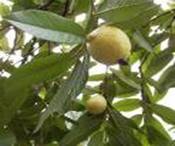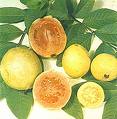| Kingdom | Plantae |
| Division | Magnoliophyta |
| Class | Magnoliopsida |
| Order | Myrtales |
| Family | Myrtaceae |
| Genus | Psidium |
| Species | P.guajava |
| Binomial name | Psidium guajava |
Other Common Names:
The other common names for the guava tree are sawintu,peera,jaam,goiaba, guayaba, djamboe, djambu, goavier, gouyave, goyave, goyavier, perala, bayawas, dipajaya jambu, petokal, tokal, guave, guavenbaum, guayave, banjiro, goiabeiro, guayabo, guyaba, goeajaaba, guave, goejaba, kuawa, abas, jambu batu, bayabas, pichi, posh, enandi and amrood.
History
Guava fruit are valued for their high Vitamin C content and aromatic flavour.Psidium guajava is native to central America from Mexico to northern South America. It has been introduced to most tropical and sub-tropical locations around the world for its edible fruit.

Description
A small tree with spreading branches and the bark is smooth, thin, copper-colored that flakes off, showing the greenish layer beneath; and also because of the attractive, "bony" aspect of its trunk which may in time attain a diameter of 10 inches .Young twigs are quadrangular and downy. Leaves are opposite on the stem, elliptic to oblong with a tapered point and are leathery, with conspicuous parallel veins, and more or less downy on the underside.



Range
Native to tropical America, the Guava is a popular fruit tree grown throughout tropical and subtropical parts of the world. It is believed to be an area extending from southern Mexico into or through Central America. It is common throughout all warm areas of tropical America and in the West Indies, the Bahamas, Bermuda and southern Florida. It is occasionally seen in Algeria and on the Mediterranean coast of France.
Habitat
It is generally seen in agricultural areas, natural forests, riparian zones and scrub/shrublands.Grows in both humid and dry climates. Tolerates wet areas, but prefers locations with good drainage. Trees die back if summer temperatures average less than 15°C, and they are also intolerant of intense daytime heat. Prefers full sun but will grow in semi-shade.
Cultivation
The Guava is a hardy plant growing in a wide range of conditions, preferring warm moist climates but tolerant of dry soils and light frost. Guava seeds remain viable for many months. They often germinate in 2 to 3 weeks but may take as long as 8 weeks. Seedlings are transplanted when 2 to 30 in (5-75 cm) high and set out in the field when 1 or 2 years old. By root cuttings the tree has been grown from root cuttings.
Pieces of any roots except the smallest and the very large, cut into 5 to 10 in (12.5-20 cm) lengths, are placed flat in a prepared bed and covered with 2 to 4 in (5-10 cm) of soil which must be kept moist. By another method, air-layers of selected clones are allowed to grow 3 to 5 years and are then sawn off close to the ground. Then a ring of bark is removed from each new shoot; root-inducing chemical is applied. Ten days later, the shoots are banked with soil to a height 4 to 5 in above the ring. After 2 months, the shoots are separated and planted out. Pruned branches may serve as propagating material.
Cuttings of half-ripened wood, 1/4 to 1/2 in (6-12.5 mm) thick will root with bottom heat or rooting-hormone treatment. Using both, 87% success has been achieved. Treated softwood cuttings will also root well in intermittent mist. In India, air-layering and inarching have been practiced for many years. However, trees grown from cuttings or air-layers have no taproot and are apt to be blown down in the first 2 or 3 years. For this reason, budding and grafting are preferred. Through seeds they are generally sown in spring in a warm greenhouse. When large enough to handle, prick out the seedlings into individual pots and grow them on in the greenhouse for at least their first winter. If trying the plants outdoors, plant them out in the summer and give them some protection from winter cold for at least their first two winters. Cuttings of half-ripe wood take place in July/August in a single frame.
Flowering Season
The white hermaphrodite flowers of the guava tree are in bloom in the month of May.
Pests and Diseases
Guava trees are seriously damaged by the citrus flat mite, Brevipa1pus californicus in Egypt. In India, the tree is attacked by 80 insect species, including 3 bark-eating caterpillars (Indarbella spp.) and the guava scale.Trialeurodes floridensis, and a weevil, Anthonomus irroratus bores holes in the newly forming fruits. The red-banded thrips feed on leaves and the fruit surface. In India, cockchafer beetles feed on the leaves at the end of the rainy season and their grubs, hatched in the soil, attack the roots. Sometimes aphids are prevalent, sucking the sap from the underside of the leaves of new shoots and excreting honeydew on which sooty mold develops. Soil-inhabiting white grubs require plowing-in of an approved and effective pesticide during field preparation in Puerto Rico.
There are other minor pests, but the great problems wherever the guava is grown are fruit flies. They are also ruined by the uncontrollable fungus, Glomerella cingulata, which mummifies and blackens immature fruits and rots mature fruits. Diplodia natalensis may similarly affect 40% of the crop on some trees in South India. Fruits punctured by insects are subject to mucor rot (caused by the fungus, Mucor hiemalis) in Hawaii. On some trees, 80% of the mature green fruits may be ruined.
Algal spotting of leaves and fruits (caused by Cephaleuros virescens) occurs in some cultivars in humid southern Florida but can be controlled with copper fungicides. A wilt disease brought about by the wound parasite, Myxosporium psidii, causes the death of many guava trees, especially in summer, throughout Taiwan. Wilt is also caused by Fusarium oxysporum f. psidii which invades the trunk and roots through tunnels bored by the larvae of Coelosterna beetles. Anthracnose (Colletotrichum gloeosporioides) may attack the fruits in the rainy season. Pestalotia psidii sometimes causes canker on green guavas in India and rots fruits in storage.
Parts Used

The fresh or the dried leaves and the fruits are the most commonly used parts of the tree for its commercial and medicinal purposes.
Medicinal Applications


• Leaves of guava are commonly used in traditional medicine, mainly to treat gastrointestinal disorders such as diarrhea.
• The leaves and the bark are used in the treatment of diabetes.
• It is very high in vitamin C, and also contains large amounts of vitamin A.
• It reduces the spasms and supports the heart.
• Guava helps in promoting menstruation and lowers blood pressure.
• It is also used in the treatment of fever including malaria, cough, ulcers, boils and wounds.
Commercial Applications


• Bars of thick, rich guava paste and guava cheese are staple sweets, and guava jelly is almost universally marketed.
• Guavas are used in pies, cakes, puddings, sauce, ice cream, jam, butter, marmalade, chutney, relish, catsup, and other products.
• Green mature guavas can be utilized as a source of pectin, yielding somewhat more and higher quality pectin than ripe fruits.
• It is good fuel wood and also a source of charcoal.
• The wood is also used in carpentery and turnery and in makings of spinning tops.
• The leaves with other plant materials to make are black dye for silk.

There is a myth about the Caribbean people for the treatment of diarrhea was to place six buds from a guava tree on the patient's tongue who chewed them thoroughly. The American version of the Christmas tree has become unique in a number of ways, primarily due to the wide variety of traditions that immigrants have incorporated in its representation. Indeed, immigration has always prompted a change in rituals and customs, especially Christmas traditions. Some unique immigrant traditions are a result of geography.
Certain countries whose climate is temperate in December have developed practices that are unrelated to the use of an evergreen tree. Instead, as in the case of Ghana, families decorate either a mango, guava or cashew tree. There is Philippine myth about the guava or "bayabas" tree compares the multi-nutritious guava fruit with the multi-faceted kindness of a boy named Bay Abas.